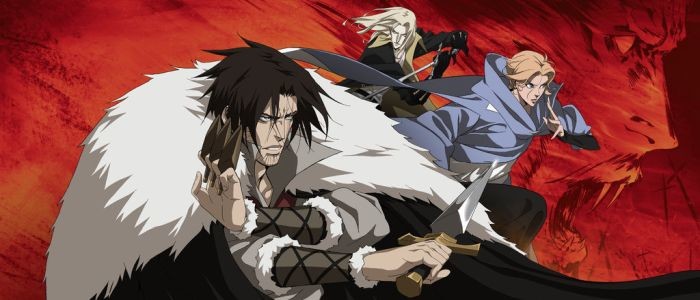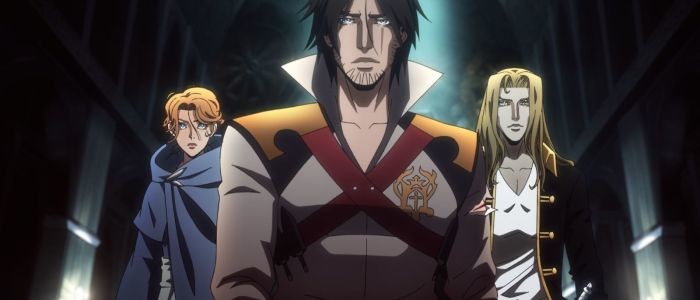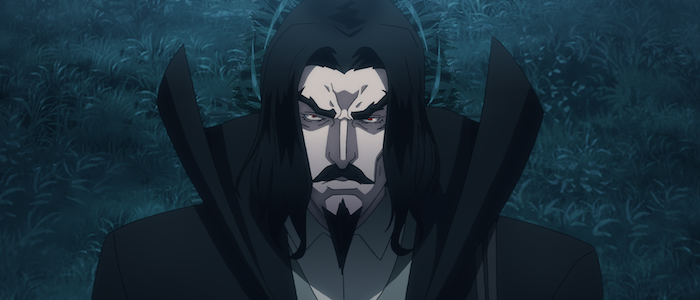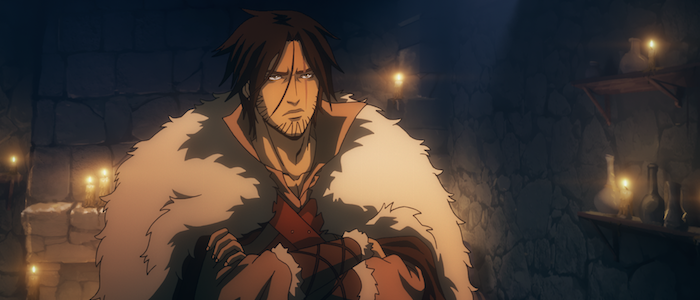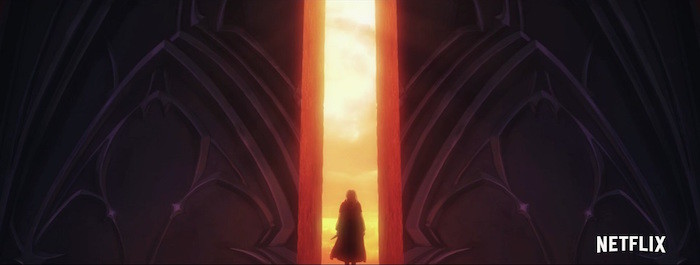'Castlevania' Spoiler Review: A Terrible TV Series, A Good Video Game Movie
(In our Spoiler Reviews, we take a deep dive into a new release and get to the heart of what makes it tick...and every story point is up for discussion. In this entry: the Netflix Original Series Castlevania.)
While the world waits in vain (vein?) for a proper 2D Castlevania sequel, the long-awaited Netflix TV show has finally been released. Originally conceived as a feature film covering the events of the 8-bit NES classic Castlevania III: Dracula's Curse, the film has been turned into a four-part TV series that will take you less than 100 minutes to watch.
The problem is that it's an absolutely terrible TV show. If this were a weekly TV show, no one would have watched past the premiere. The fact that (as typical for Netflix) it's all available at once and bingeable doesn't change that it's broken up into pieces that make absolutely no sense by themselves.
No, this was never meant to be seen one at a time. Castlevania is a sneaky 100 minute movie, and the sooner you realize that the quicker you'll appreciate it, because it has a lot of good going for it.
Dracula’s Curse
Castlevania is a famous game series that's all about Dracula being hunted by various descendants of the Belmont clan, usually after his castle has appeared and unleashed monsters on the world. Considering that Dracula never had much to say in the games except his thoughts on men's souls, the amount of background Dracula is given here is a little surprising. But you're only as good as your villain, after all.
The show starts off in Wallachia in the 1400s as Dracula lives alone in the impossible architecture of his castle, a monstrosity decorated only by the impaled skeletons of those who once opposed him. But he's got an unexpected guest: Lisa.
First revealed in the PlayStation One classic Castlevania: Symphony of the Night, no one really knows much about Lisa, Dracula's second wife. All the game says was that she became involved with Dracula, who loved her because he looked like his previous wife Elisabetha. Together they had a son, Alucard (say his name backwards), a tortured soul who appears later on in the show.
Here, Lisa is a woman interested in the science Dracula is holding for himself, and she is unafraid of him as she has already been cast out from humanity for believing in science. They soon fall in love and she pays for it in the worst possible way, getting burned at the stake by religious men while Dracula is away on vacation.
"Forgive them," she yells as she does her best Lisbeth Nypan impression, "They don't understand. They don't know what they're doing! Be better than them!" If that deification of the Count isn't enough, he comes back to find her dead and turns into a fire deity of sorts, giving the town an ultimatum – prove their worth in a year, or be destroyed. He is pissed beyond reason, and only some good old fashioned genocide can sate him. Guess what happens.
Rondo of Blood
When he comes back in a year, a year in which the church does its usual thing and gives the people bad advice, Dracula finds everyone still there and starts his killing. He teleports his castle right into town and opens the shutters to unleash a horde of monsters, which start killing the townspeople in sight, all while blood pours from the skies.
When the killing starts, it doesn't skimp. If you jump in, be prepared for one gnarly show, as the end of the very first episode shows that they're not fooling around. People get slashed into pieces and one unlucky soul gets a demon's talons stabbed right through his face. You don't show the dead eyes of a kid that's been sliced in half unless you're serious about the stakes.
Even a simple bar brawl spills more blood than most entire shows. This series is just steeped in violence and irreverence, most notably in how delightfully villainous the Bishop and his church are. Most of the humans aren't really worth saving here.
Since the humans are such good villains, it's maybe no surprise that the show doesn't have much to offer in creature variety, a place you'd think it would excel. The Castlevania games are known for some amazingly inventive monsters, but here we only get a handful, most of which are just winged demons. Considering that the video game series has featured nearly every single famous horror monster in existence, it's a strange omission.
Even if they had just focused on the creatures from its source material in Castelvania III, they would have had quite the menagerie to choose from. The opening of the third episode sees Trevor fighting a Cyclops, who appears as a mini-boss in the game, but where are the others? This is a game that has you fighting such fun enemies as Death, Dragons, and Frankenstein's monster, although the latter makes sense for its lack of inclusion.
(One can only hope that if the series continues Legion will appear. I don't mean the son of Professor X either, I mean the giant ball of corpses that Alucard faces in his dad's castle.)
Aria of Sorrow
There are lots of nice little touches for fans of the series though, such as when our heroes end up exploring a catacomb and end up jumping around on giant geared wheels, a series mainstay.
Their armament is straight out of the game, too. The Castlevania series usually has you controlling a whip-wielding Belmont, and while you can upgrade the whip, there's also a number of sub-weapons to nab. Trevor gets his hand on a number of these in the show, including throwing daggers, an axe, and even holy water, which he commissions from a nearby priest. There's no magic stopwatch that stops time or battle cross that works as a boomerang, although a number of crosses are destroyed and used as weapons over the course of the series.
Belmont’s Revenge
Trevor Belmont (Richard Armitage, best known as Thorin Oakenshield from The Hobbit) is first glimpsed getting yelled at by some bar patrons at the end of the first episode, and the second episode is entirely him finishing that fight, starting a new one, and talking with a town Elder once he's sobered up. Even when completely drunk, he's a beast in combat and he spends more time in this series fighting human enemies with that whip of his than he does monsters.
Making him a drunk is an interesting turn, but it does turn him into an unwilling hero, a comic figure that owes more to Ash from Army of Darkness than you'd expect. He's dim, but good in a fight and engages in plenty of physical humor, including getting hit in the crotch twice in his very first fight. When he does inevitably live up to his family's bloodline, he trains the villagers to fight an undead army.
Trevor's change from drunken lout to reluctant hero to shining knight in armor happens in an absurdly quick amount of time, but that's what happens when you only have four episodes to tell your story.
Trevor is joined by Sypha Belnades, whom he finds turned to stone. One of the four playable protagonists of Castlevania III, Sypha was the stereotypically weak and fast one. She's a magic-user whose weapon of choice is a staff, and like Alucard, she only gets one sub-weapon, the Stopwatch. She gets a number of spells in the game and one does appear here (a spell that shoots out frozen crystals), which comes in handy when Trevor is trapped in a fire circle at one point.
But she doesn't get a whole lot to do here. We may have made great strides in female representation in video games, but the only way Trevor knows how to interact with her at first is "Ooh, it's a girl!" Even when he is saved by her, he doesn't make a big deal of it, even though he makes sure to mention how hard it was when he saves her from a Cyclops when they first meet. Trevor, ever the '80s hero.
Bloodlines
Trevor's best moment comes near the end of the criminally short series, when he descends into some Catacombs to reveal Alucard, who's easily the most interesting character in the show. Voiced by James Callis (Gaius friggin' Baltar himself!) the son of Dracula and Lisa is a refined yet tortured soul, and his conversation with Trevor finally makes him drop all of his pretense and actually discuss the issues facing them. It's amusing that Castlevania is at its best when it takes itself seriously, rather than just showing heaps of corpses and people getting hit in the balls.
Of course, they end up butting heads immediately, which culminates in an incredible and stylized duel, one that's more thrilling than any of the others in the series. Alucard gets to show off his sword skills and teleporting ability here as well, although he doesn't take the form of a bat or wolf (yet) as he can in the games. Of course, most people know Alucard from his star-making turn in Symphony of the Night, which has the distinction of not only being inarguably the best Castlevania game ever made, but one of the finest games of all time, period. It's a lot for a character to live up to, but if they wanted to continue this series far into the future, there's no better way than with the immortal half-breed.
Legacy of Darkness
Alucard, Sypha, Trevor. Those are three of the four playable characters from Castlevania III, but hardcore fans may be wondering where the most fun little guy is? Sadly, Grant has not made it to Wallachia, and that's entirely writer Warren Ellis' fault.
"Yes. I cut Grant DaNasty out of the film," he said in a blog written a decade ago that was recently unearthed by Bleeding Cool. "What use is a pirate in a landlocked country anyway?"
Ellis went on to state the many (justifiable!) reasons why Grant didn't make it into the film or eventual TV show, including his stupid name (Grant. DaNasty.) and the running time of the project, which made him struggle to create backstories for everyone else as well. And also, once again, he hates the idea of a pirate on dry land.
Ellis seems to have gotten most of the rest of his ideas out easily, though. Netflix has been good with handing money over to creators and letting them do their own thing. When that's combined with producer Adi Shankar, a man famous for taking known properties and making them into ultraviolent, "adult" extravaganzas, you've got an absurdly bloody take on a video game. He recently wrote in a Facebook post that he is "personally guaranteeing that this is going to be the best f*cking video game adaptation ever made to date" and you know what? He may have pulled it off. Low bars and all that, but it's an achievement nonetheless.
Dawn of Sorrow
Fortunately, a second season of Castlevania has already been ordered, with twice the number of episodes. Eight episodes is something this first season could have definitely used, as it feels rushed and incomplete as it is.
The script is very good, but the show is undermined by its very format. Each episode basically acts as an origin story for one of the main characters – Dracula, Trevor, Sypha, and Alucard – and then it's over.
"We three," states Alucard after he meets his new companion,. "We can destroy him." And they walk off to a credits sequence. For now, we once again wait for Dracula's castle to return to get that proper Castlevania feeling once again. At least in the meantime, we have Dead Cells.

